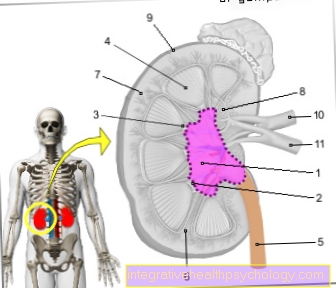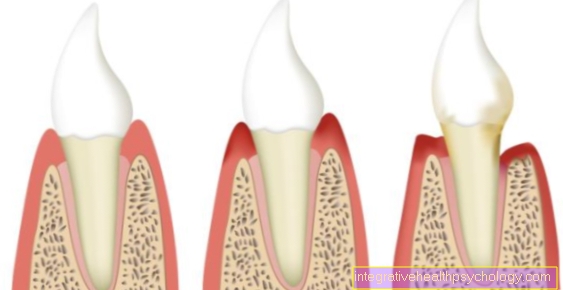What are amino acids?
definition
Amino acids amino acids) are the building blocks of proteins (Egg whites) and occur in every cell of a living being.
They can be divided into two groups, the essential (cannot be made in the body) Amino acids and the non-essential (can be made in the body) Amino acids.
There are a total of 20 amino acids that can combine to form a wide variety of proteins. The eight essential amino acids are offset by twelve non-essential amino acids. According to the latest research, the group of proteinogenic (necessary for the production of proteins) Amino acids are increased to 23. If you look not only at the proteinogenic amino acids, but at all existing amino acids, you have to find that there are well over 200 amino acids. However, most of these amino acids have nothing to do with protein synthesis in the body.

Effect of the amino acids
As the smallest building blocks of proteins, amino acids are involved in many processes in the human body. They occur in many organs and control metabolic processes and enzymes.
The individual amino acids combine to form long branched chains depending on their destination and task. Depending on which and how many amino acids are combined, different effects develop and thus also different locations.
Amino acids play a role in endurance, performance, regeneration and susceptibility to injury. But amino acids can also help with depression and negative moods can be reduced by amino acid preparations. Amino acids can also strengthen bones and cartilage and they can also help with erectile disorders in men. They play a role in the production of new blood cells as well as in the release of hormones. As a result, they are also indirectly responsible for energy control and, through the release of testosterone, amino acids can contribute to muscle growth and also control these processes.
When building muscle and increasing performance, amino acids are required to always provide energy and to form new muscle cells. Amino acids are important for regeneration because immediately after training in the body they are jointly responsible for building up the muscles and replenishing nutrient stores. A deficiency becomes noticeable here in fatigue, depressed mood and listlessness, which also affects performance. In this case, the immune system is also weakened and the body is more susceptible to illness and injury.
If you notice deficiency symptoms such as depression, immune deficiency or fatigue, this can be due to a low amino acid level. Even if the human body does not have any direct amino acid stores, there are around 200 grams of amino acids in what is known as an amino acid pool, which is always available to the body.
Competitive athletes and bodybuilders use amino acid preparations in order to always provide the body with sufficient energy and to positively influence the ability to regenerate and muscle building.
Does it make sense to take amino acids?
The ingestion of amino acids is essential for humans. Proteins, the basic building blocks of which are amino acids, play a major role in all of our tissues, in the metabolism and for the immune system. Many amino acids have to be taken in with food. Protein is found in high amounts Meat, legumes or dairy products.
The body can release the amino acids from the ingested protein and channel them into its own metabolism. He can produce some amino acids from others, i.e. synthesize them. Others (the essential amino acids, see above) must, however, be supplied in sufficient quantities. A normal working person needs around 1.2-1.5 g of protein per kg of body weight every day. This requirement is increased with sporting activity and especially with strength training (approx. 2g / kg).
Since a sufficient intake of high-quality essential amino acids may no longer be guaranteed, supplementation makes sense in such cases. However, the dietary supplement should be taken with care. Excessive protein intake can lead to water retention and even damage the kidneys in the long term.
Side effects
Since amino acids are natural and essential basic substances for a healthy diet, side effects usually do not occur, or only in rare cases.
Side effects can occur if drugs are taken in addition to the supplementation of amino acid preparations. If this combination of amino acids and medication is not discussed with a doctor beforehand, the effect of medication can be intensified or weakened. It can also happen that medication is completely neutralized and no longer has any effect.
If you ignore the dosage recommendations for amino acid preparations, gastrointestinal complaints can occur in some cases, including diarrhea and nausea.
Therefore, you should always adhere to the recommended daily and intake doses in order to develop the full effect of the amino acids.
Amino acids can have a damaging effect if too much protein is supplied and the body no longer breaks this protein down into its amino acids because these are no longer needed. Then the body may produce too much uric acid, which can be deposited in the joints in the form of crystals. There they can possibly lead to gout. But the kidneys also suffer from the high amount of uric acid and kidney stones can form.
Are amino acids suitable for weight loss?
Many manufacturers use it advertisedthat the regular intake of amino acids in the form of dietary supplements can lead to an increased production of slimming hormones, increased fat burning and at the same time to an increase in muscle building. However, scientific studies have not yet been able to prove the effectiveness of amino acids for weight loss.
More about this topic can be found: Lose weight with amino acids
Amino acids are vital components of the human organism; they play an important role in metabolism, muscle and tissue development and the protein balance.
Some amino acids are essential, which means that the body cannot make them itself, so they must be obtained from food.
But amino acids, which the body can produce itself, must also be supplied through food for healthy growth and a protein balance. A balanced diet is basically sufficient to ensure that the body is adequately supplied with the important amino acids.
A sufficient supply of amino acids leads to an improved regulation of the feeling of satiety, the insulin level, as well as the production of important messenger substances in the brain.
There are many different theories about the possible role amino acids could play in weight loss. For example, amino acid deficiency symptoms are said to cause the insulin level to drop quickly and thus trigger cravings.
A deficiency in amino acids becomes noticeable through symptoms of fatigue and difficulty concentrating, but should always be confirmed by a doctor before therapy with an intake of amino acids is started. Weight reduction through amino acids is supported on the one hand by promoting fat burning and on the other hand by curbing the appetite. Above all, the amino acids arginine, lysine, phenylalanine and ornithine play an important role. Arginine, lysine and ornithine are said to stimulate growth hormone, which promotes fat mobilization and fat burning.
Phenylalanine stimulates the production of another hormone (cholecystokinin), which acts as a regulator of hunger and appetite. Cholecystokinin is formed in the intestinal wall and triggers a chain of signals that signals satiety and stops further intake of food.
The amino acid L-carnitine is often mentioned in connection with weight loss. L-carnitine is produced by the body itself and is also contained in meat, fish, poultry and milk. Carnitine is supposed to mobilize fatty acids from the fat cells (Adipocytes) and increase the burning of fatty acids. The amino acid glutamine helps generate energy because it can be converted into glucose (sugar) in the kidneys. Glutamine is supposed to counteract the storage of dietary fat and thereby support weight loss.
Under competent professional supervision, an amino acid administration can support weight loss by balancing the nitrogen balance and avoiding muscle breakdown.
However, there is no such thing as a "miracle pill" for losing weight. Ingesting amino acids cannot provide a quick and easy solution either. If you really want to lose weight, you have to rethink everyday behavior, reduce your energy supply and increase sporting activities.
Taking amino acid supplements can also cause side effects. There is currently insufficient experience with the possible undesirable effects of amino acids, but a previously undiscovered kidney disorder, for example, can be aggravated with the additional intake of amino acids. It is recommended that you discuss the intake of amino acids to support weight loss with your doctor.
Amino acids to build muscle
Amino acids are the basic building blocks of proteins. Our muscles also consist of protein and thus of amino acids. There are 21 amino acids that are assembled into enzymes and also structural proteins in the human body during protein synthesis. For this, however, the amino acids must be available in sufficient quantities. Amino acids are usually absorbed in sufficient form through a balanced diet, but athletes, and especially strength athletes, also have an increased need (2g protein per kg body weight instead of 1.2-1.5g). It can happen that especially the essential amino acids, which we cannot build up independently from others, have to be supplied in the appropriate form because they are not available in sufficient quantities.
Not only can this inhibit muscle growth, it can even lead to the breakdown of muscle tissue. Proteins can also be used as an energy source if you exercise too much and use a lot of energy. After the glucose and glycogen stores have been used up, proteins are also metabolized. If too little protein is absorbed with food, the body's own protein stores, namely our muscles, are attacked and instead of increasing muscle mass, a certain amount is always broken down. Sufficient energy should be available during training, but especially in the regeneration phase, so that the body can use this to build muscle. The anabolic (mmuscle building) Effect of amino acids, these are often used in weight training.
Read more on the topic Amino acids and muscle building
Amino acids as a supplement in sports
In order to ensure sufficient supply during the regeneration phase and thus muscle building, but also to prevent its breakdown during training, it is advisable to supplement amino acids as a dietary supplement if there is an increased need. A high-quality range of amino acids should be ensured here.
The essential amino acids are: Leucine, Isoleucine, Lysine, Valine, Phenylalanine, Tryptophan, Methionine and Threonine. The so-called BCAA's (English acronym for branched-chain amino acids: leucine, isoleucine, valine) are known in amino acid preparations.
Read more on the topic: BCAA- You have to pay attention to this
Also important for athletes is arginine, which often cannot be synthesized in sufficient quantities when there is a high demand. Amino acids such as carnitine, which are not found in the structure of the body's own proteins, but are important for metabolism (fat metabolism), are also used in food supplements. If there is an increased consumption and need for amino acids, as is the case with athletes, appropriate supplementation makes sense to support muscle building and prevent its breakdown.
For this reason, people who do sport regularly and want to build muscle mass should attach great importance to a balanced diet and consume especially the essential amino acids in large quantities. Muscle can only be effectively built in an organism that is able to synthesize proteins itself. In addition, the regular and sufficient supply of proteinogenic amino acids is also important for the supply of existing muscles. A long-lasting deficiency would ultimately lead to a significant muscle loss.
People who exercise regularly can take supplements that are high in amino acids. These dietary supplements can be purchased as tablets or juices, as well as in the form of bars. Supplementing with pure amino acids can by no means be seen as a substitute for a balanced and protein-rich diet for those who love sports.
Dietary supplements that contain amino acids are usually taken a few minutes before and a short time after exercise. In this way, muscle building can be effectively increased during the training session.Not all proteinogenic amino acids are equally suitable for promoting muscle building. Most athletes take supplements that are high in glutamine. Glutamine has a share of around 60 percent in muscle tissue and for this reason plays a decisive role in muscle building.
Other amino acids that can effectively increase muscle growth are:
- L-arginine
- Beta alanine
- Citrulline
However, caution must be exercised when taking simple amino acids. The dietary supplement with amino acids only makes sense for competitive athletes who regularly complete intensive training units. In addition, the amino acid-containing preparations should only be taken as long as there is an increased need for these protein building blocks. In addition, it has been shown in many cases that people who do intensive sport do not tolerate certain amino acids and develop side effects while taking them. In such cases, supplementation must be stopped immediately. Affected athletes should also consult a doctor and be examined for an intolerance. A specialist can then decide whether the amino acid in question should no longer be taken or whether a reduction in the dose may be sufficient.
Read more on this topic: Amino acids in sports
Amino Acids Against Hair Loss?
As hair loss becomes a growing problem, the effects of dietary supplements on hair loss have been studied and it has been found that amino acids in particular Lysine, Cysteine, Methionine and Arginine have positive effects on hair loss.
The hair and the hair root need different building blocks for the formation of keratin and the protection and care of the hair. A lack of these substances, which are important for the hair, can lead to poor hair quality and also to hair loss. Conversely, supplementing with these amino acids can help stop excessive hair loss and support hair formation.
Foods high in amino acids
All amino acids can be consumed through food. The various amino acids are found in various concentrations in a wide variety of animal and plant products.
Amino acids are found in the form of proteins in many grain products. Whole grain spelled flour with 13.3 grams and wheat germ with 26.6 grams per 100 grams of plant-based foods contain a lot of amino acids in the form of protein. Soybeans and lentils are also high in amino acids at 33 grams and 23.5 grams and should therefore be part of a balanced diet.
In general it can be said that cereal products, nuts and legumes contain a lot of amino acids. These examples belong to the group of vegetable amino acids. You can also get amino acids through animal products. Meat and sausage products, fish and dairy products stand out from this group. Among the sausages, cooked ham, smoked ham and poultry sausage are some of the products with the highest amino acid content. In addition to amino acids, fish products also contain vital substances and vitamins. Tuna, halibut, trout, mackerel, pike, perch and carp are particularly high in amino acids.
When it comes to dairy products, it is mainly yoghurt and buttermilk that stand out for their amino acid content.
Dosage of ingested amino acids
For people who do little or no sport, there are no precise dosage recommendations, as the required amount of amino acids is clearly covered with a balanced and healthy diet. The German Nutrition Society (DGE) also recommended that popular sports should not take additional amino acid supplements, but instead eat a balanced diet.
For people who are more physically active, the recommended dose is between 1.2 and 1.4 grams per kilogram of body weight. For strength and endurance athletes, this range is slightly higher at 1.6 to 1.7. The amino acid supplementation recommended here is explained by the body's increased need for amino acids (proteins). The individual amino acids, such as phenylalanine, glycine, arginine, aspartic acid, carnitine, cysteine, glutamine, etc. can also be taken individually as dietary supplements. As a result, it is difficult to give a general dosage recommendation, rather each individual amino acid has its own dosage recommendation that should be followed.
Chemistry of Amino Acids
Amino acids are of great importance in the chemical processes of living beings (biochemistry), as they form the building blocks of proteins (peptides and proteins). The genetic material (genome) encodes twenty-two amino acids from which vital proteins are made. These twenty-two amino acids are called the so-called proteinogenic amino acids.
Amino acids are strung together in chains and, depending on the length of an amino acid chain, one speaks of either peptides (up to 100 amino acids) or proteins (more than 100 amino acids).
The proteinogenic amino acids are divided into different groups, depending on which reactive side chains they have. This also gives rise to the various chemical-physical properties of amino acids. For example, if an amino acid has only one long, non-polar side chain, this influences, among other things, the solubility properties of the amino acid.
In addition, the pH value (measure of the acidic or basic character of an aqueous solution) plays an important role for the properties of the side chain, since the side chain behaves differently when it is charged or uncharged. For polar solvents, for example, charged side chains make an amino acid more soluble, while uncharged side chains make the amino acid more insoluble.
In proteins, many differently charged amino acids are attached to one another, making certain sections more hydrophilic (water-attracting) or hydrophobic (water-repellent).
For this reason, the folding and activity of enzymes (catalysts of biochemical reactions, perform important functions in metabolism) depends on the pH value.
The charges and the dissolution behavior of the side chains also explain why proteins can be denatured by strongly acidic or basic solutions.
Amino acids are also known as so-called zwitterions, as they can carry different charges depending on the milieu (positive or negative charges). This phenomenon is due to the two functional groups of an amino acid, i.e. the amino and the carboxyl group.
In simplified terms, one can remember that an amino acid that is dissolved in an acidic solution has a positive charge and an amino acid in an alkaline solution has a negative charge. In a neutral aqueous solution, amino acids are equally present in positive and negative charge form.
The proteins or amino acid chains can be destroyed through contact with heat, acids and alkalis and thus become unusable.
The division of the proteinogenic amino acids into polar or non-polar amino acids is also done according to the functional groups. The classification according to the chemical-physical properties of the individual amino acids is not only based on polarity, but also according to character, molar mass, hydrophobicity (water-repellent property), acidity or basicity (acidic, basic or neutral amino acids) and according to the electrical properties of the amino acids.
In addition to proteinogenic amino acids, there are also a large number (more than 400) of amino acids that do not occur in proteins, the so-called non-proteinogenic amino acids.
Examples are L-thyroxine (thyroid hormone), GABA (inhibitory neurotransmitter), ornithine (metabolic intermediate in the urea cycle), and many more. Most of the non-proteinogenic amino acids are derived from the proteinogenic amino acids.
Chemical structure of amino acids
Each of the 20 proteinogenic amino acids has at least two carbon atoms (C atoms). It is precisely this carbon atom that is essential for the classification of the respective amino acid. This means that the carbon atom to which the amino group is attached determines which class of amino acid it is. However, there are also amino acids in which several amino groups are represented. In such cases, the carbon atom whose amino group is closest to the carboxy carbon determines which class of amino acid it is.
In general, a distinction is made between alpha-amino acids, beta-amino acids and gamma-amino acids:
- Alpha-amino acids: The amino group of this class of amino acids can be found on the second carbon atom. Another name for these amino acids is 2-aminocarboxylic acids (IUPAC name). The most important representative of this class is the amino acid glycine, which has a very simple structure. Judging by their structure, all amino acids important for the human organism are counted among the alpha amino acids. In this case one speaks of so-called proteinogenic amino acids. They are the building blocks from which all proteins are built.
- Beta-amino acids: The class of beta-amino acids is characterized by the fact that their amino group is located on the third carbon atom. The IUPAC designation is also synonymous for this class "3-aminocarboxylic acids" used.
- Gamma amino acids: The amino group of all amino acids from the gamma group is attached to the fourth carbon atom. The structure of the amino acids of this class differs significantly from the structure of the proteinogenic amino acids. The IUPAC name of this group is 4-aminocarboxylic acids. Although gamma-amino acids are not used for the synthesis of proteins in the human organism, some representatives of this class can be found in humans. The simplest representative of this group, gamma-aminobutyric acid (GABA for short), serves as an inhibiting neurotransmitter (messenger substance) in the nervous system.
Although the amino acids have a similar structure within the individual classes, they differ in the structure of their side chains. It is precisely the individual components of the side chains that are responsible for the behavior of the amino acid in an acidic or basic environment.
About twenty amino acids occur in nature, although humans can only build up a few amino acids themselves. Amino acids, which the body is unable to produce, are called essential amino acids. Humans have to take in these amino acids through food.
Essential amino acids in adult humans are:
- Leucine
- Isoleucine
- Methyonine
- Threonine
- Valine
- Lysine
- Phenylalanine
- as well as tryptophan.
The amino acid cysteine is not essential in the strict sense, but it is indispensable as a source of sulfur for the human body. In infants, histidine and arginine are also essential.
Amino acids can enter into chain-like combinations with one another. One speaks then of protein molecules (proteins). The combination of amino acids determines how a protein works and what it does. The amino acid combination is not arbitrary. It is specified accordingly in the corresponding gene (coded). Always three base pairs, which are arranged in a certain way, correspond to a so-called code word (= codon). This codon represents the building instructions for the respective amino acid.
Test to determine an amino acid deficiency
Amino acids are essential for various metabolic pathways, the hormonal balance and other important processes within the organism. For this reason, a sufficient supply of essential amino acids, or the components of synthesizable amino acids, is of enormous importance.
The extent of a deficiency in these substances becomes clear when you keep in mind that the body consists largely of amino acids (or proteins) in addition to the high proportion of water. Nowadays, when it comes to nutrition, there is an excess of carbohydrate-rich foods. Many people eat foods rich in carbohydrates almost exclusively. In many cases, the supply of amino acids is neglected. If too few amino acids are consumed over a longer period of time, there is a lack of food. As a result, sooner or later the organism switches to emergency mode and saves energy wherever possible.
Many people who consciously refrain from eating certain foods (for example vegetarians or vegans) ask themselves whether there are tests with which a possible amino acid deficiency can be detected and proven at an early stage. The aim of such tests is to prevent the long-term side effects of an amino acid deficiency situation.
One of the most common and easiest to perform tests to detect an amino acid deficiency is based on a simple principle. When the organism switches to emergency mode due to the lack of amino acids, it reacts, among other things, with a reduction in water excretion. So it holds back large amounts of water. As a test, those affected can therefore first pay attention to whether urination is going on as usual or whether noticeably less urine is being passed.
In addition, the decreasing excretion of water is evident from water retention (edema) in the tissue. The development of edema can therefore be directly related to a lack of amino acids. The extent of the amino acid deficiency is directly related to the amount of stored water. A simple test can help patients concerned with water retention caused by an amino acid deficiency to assess whether they have edema.
The test is to be carried out as follows: The affected patient should let his arm hang down relaxed on the body. Meanwhile, the other hand must be placed on the back of the upper arm. Your fingertips should almost touch your upper body. The patient must place the whole hand as flat as possible on the arm and exert light pressure on the tissue of the arm hanging down. Just like performing it, evaluating this test is quite simple. The firmer the tissue, the less water retention there was. With regard to the amino acid balance, this in turn means: the firmer the tissue, the less pronounced (or nonexistent) the amino acid deficiency.
Furthermore, such water retention can be tested well on the ankles. After a slight pressure has been exerted on the ankle region, if edema is present, there is a retraction, which only disappears after a long time. However, when performing an amino acid deficiency test, patients should be very careful that tissue swelling caused by water retention may have other causes. For this reason, a positive test result should only be associated with an amino acid deficiency if there are no other underlying diseases. In addition, if such water retention is present, a doctor should be consulted and the cause clarified.
If there is actually a pronounced deficiency in amino acids, the attending physician can help bring the amino acid balance back into balance by changing your diet or by taking food supplements.
Summary
Amino acids are found in both plant and animal products and have many important functions in our body. For example, they control many metabolic processes, are involved in the production of energy and are of enormous importance, especially for building and maintaining muscles. That is why it is very important for endurance and strength athletes to always have enough amino acids in their body.
Amino acids can be divided into essential and non-essential amino acids. In contrast to the non-essential amino acids, the human body cannot produce the essential amino acids itself, and so they can be obtained from food. However, through a healthy and balanced diet, it should not be a problem to meet the daily requirement of amino acids.
Athletes are an exception here and should in certain cases supplement amino acids in order to prevent muscle breakdown and ensure a permanent supply of energy.
An overview of other dietary supplements
- Amino acids in sports
- Amino Acids To Build Muscle - What You Should Know
- Amino acid tablets
- List of amino acids
You can find more information about the following dietary supplements:
- BCAA
- CLA
- Glutamine
- HMB
- carbohydrates
- L-carnitine
- protein
- Pyruvate
- Ribose
- Ribose-5-phosphate
- Weight gainer
- Tribulus Terrestris
- Creatine





























